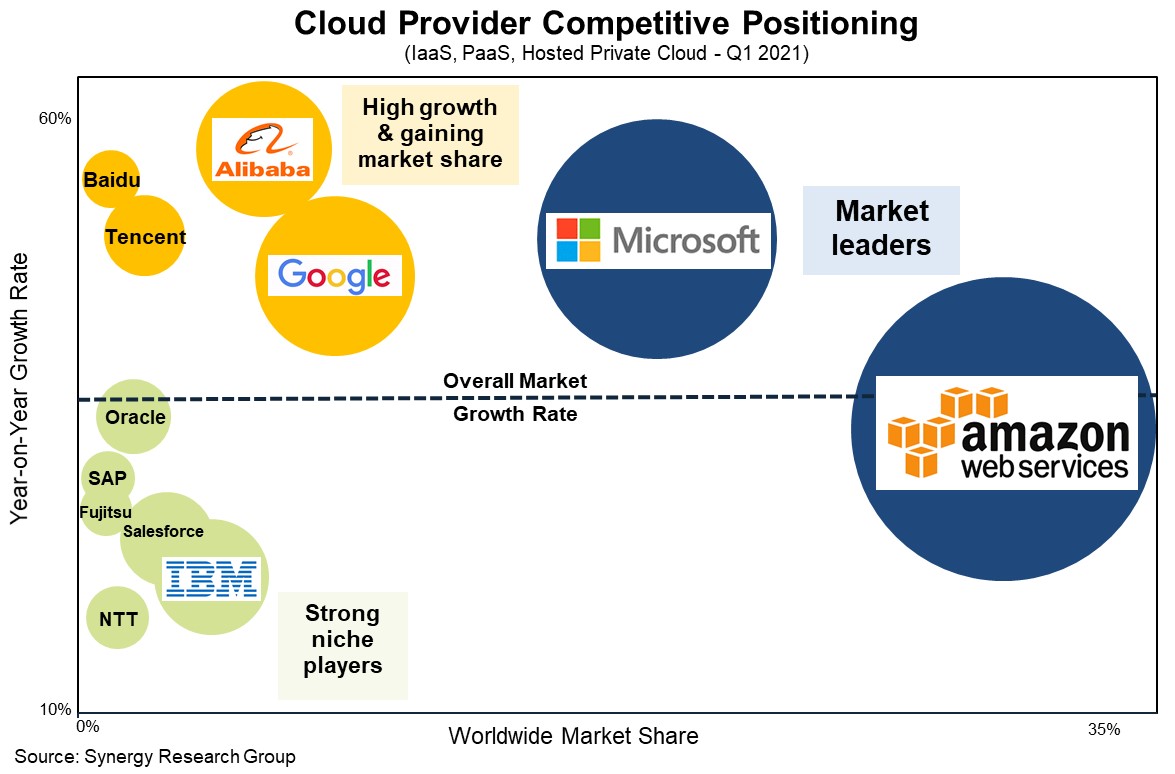The cloud service provider (CSP) oligopoly is nothing new. The first major articles on it appeared in 2013. The difference now, nearly a decade later (and about 15 years since the popular software’s introduction), is that there’s no longer a chance for smaller players to disrupt the game. Let’s dive into the companies that make up the oligopoly, how we got here, and what it means for your business.
Who Runs the Cloud?
You know the major names in cloud computing: Amazon, Microsoft, Google, and Alibaba. With the exception of the latter, all major CSPs are based in the United States. The top five players listed below control a whopping 80% of the cloud computing market share—hence, the oligopoly.

Amazon
Amazon leads the pack by a mile, due in no small part to launching AWS, its cloud division, back in 2006, several years before any mentionable competition. It’s held a solid third of the market share for years and somehow continues to grow, helped along by the massive switch to the cloud spurred by the Covid-19 pandemic.
Microsoft
Second only to Amazon, Microsoft had roughly 20% of the market share by the end of Q1 2021. Microsoft is far enough ahead of the competition that they needn’t worry about anything other than closing the gap between them and Amazon. With a growth rate of 50% each of the last three quarters, Microsoft isn’t relinquishing control any time soon.
Google can claim 9% of the market right now, closer to its downmarket competitors than the two racing ahead. Since 2018 Alibaba has regularly jockeyed with Google for the number three spot.
Alibaba
Alibaba, the Chinese ecommerce giant, started investing heavily in its global cloud presence a few years ago with near-immediate results. It’s the only non-American member of the cloud oligopoly. When they decided to expand their cloud presence outside of China in 2015, president of Alibaba Cloud Simon Hu announced, “Our goal is to overtake Amazon in four years, whether that’s in customers, technology, or worldwide scale.” While that didn’t happen, they have made quite a dent in the market—jumping right into the top five and continuing to grow.
Fellow Chinese company Tencent is also growing at a swift rate. When combined with Google and Alibaba, they control 19% of the public cloud market.
Why Is There a Cloud Oligopoly?
First and foremost the barrier to entry is markedly high. It requires serious capital to get started, the kind of funds that only major corporations like Microsoft and Amazon have. We often discuss how cloud VoIP is a great choice for smaller businesses because it skips the initial fixed costs of onsite PBX setup, whereas a massive enterprise can handle the physical space and financial investment necessary. Smaller companies have tried to get into the game and either failed or were acquired by a larger group. There’s always a bigger fish.

This is called the economy of scale, and because of it we’re now at a point where no startup on its own can decentralize the cloud. It’s impossible. The capital necessary to even make a dent in the game is far beyond the reach of anyone not already a global tech power. So we’ve reached an impasse of sorts. The only way to break up the US-dominated cloud oligopoly is with legislative power. Other countries and regions are already looking into this as a matter of fair trade. The United States needs to catch up.
In the meantime however, most businesses have no choice but to wait and keep using one of the major players. And that poses several risks.
In the cloud world, five companies have an increasingly solid grip on 4/5ths of the IaaS/PaaS and hosted cloud market; the remaining 20 percent is split among the rest of the top 12 list. In comparison to “The Big Three” (which we suppose is now the Big Four or Five), more than doubling the number of players to round out the market share doesn’t sound so bad. But only 12 companies making up nearly the entire cloud world? That’s scary. Whether you approach from a cybersecurity standpoint or resilience, there’s more pros than cons to a cloud oligopoly.
Why the Cloud Oligopoly Is Dangerous for Business
Fewer major players in cloud tech mean that services and features are consolidated and easier to access in one place. But that also means there are fewer points of failure. If one CSP goes down, even for a short time, every business using it is disrupted. And with so few providers, that’s a risk for nearly every business out there, regardless of size. This isn’t even a worst-case scenario hypothetical—it happens more frequently than comfort allows.
Cloud computing has championed our shift to remote working, but we have never placed so much faith in such a small number of tech companies.”
AWS went down in 2017, taking Slack, Trello, Medium, and Grammarly, among others, with it. If your business runs on AWS you likely remember this. In June 2019 Google Cloud went down due to network congestion. That happened again in August and December 2020. The former was just Google Drive and Gmail, while the latter was a full Google Cloud outage that lasted 45 minutes. If you know anything about downtime impact, we’ll let you do the math on the financial impact of that “short” outage.
The bottom line is that this oligopoly in particular is dangerous. When so few CSPs control and run the cloud, even a minor outage has a massive ripple effect on productivity. And that’s not even touching the data issue. Cloud providers strategically avoid liability for data loss (read the fine print, folks). Essentially, we have business resilience, data protection, and general daily functionality for pretty much the whole world at risk right now. So where do we go from here?

